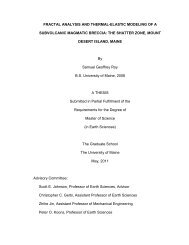Latis II Underwater Remotely Operated Vehicle Technical Report
Latis II Underwater Remotely Operated Vehicle Technical Report
Latis II Underwater Remotely Operated Vehicle Technical Report
You also want an ePaper? Increase the reach of your titles
YUMPU automatically turns print PDFs into web optimized ePapers that Google loves.
SOFTWARE<br />
LATIS <strong>II</strong><br />
The cRio controller on the ROV is programmed<br />
using National Instruments LabVIEW software.<br />
LabVIEW is a graphical programming language<br />
that allows users to create programming code<br />
through control block diagrams rather than<br />
traditional line code found in BASIC or C. Since<br />
most of the team did not have any experience<br />
with C or other typical controller programming<br />
languages, the graphical format of LabVIEW<br />
allowed the team to focus their efforts on the<br />
actual content of the program, rather than<br />
learning the syntax.<br />
MAIN HOST AND DASHBOARD<br />
The core component of the software is the main<br />
host program (called a virtual instrument, or<br />
VI). The main host contained the code for all of<br />
the inputs and outputs for the ROV, including<br />
sensors, thrusters, and the arms. The front<br />
panel of this VI contains displays and indicators<br />
for many of the ROVs vital functions.<br />
9<br />
Figure 9: LabVIEW Dashboard<br />
VENT MISSION SUB-VI<br />
To increase the modularity of the system, the<br />
vent mission code is broken out into a sub-VI.<br />
When performing this mission, the pilot presses<br />
a button on the dashboard to load this program<br />
separately. The program then allows the pilot<br />
LATIS <strong>II</strong><br />
TECHNICAL REPORT<br />
to record the three temperatures, chart the<br />
data, and show the judge before closing the<br />
program. Having this code as a sub-VI helps<br />
free up space on the main dashboard for other<br />
indicators. This setup also allowed the team to<br />
create and test the code for this mission before<br />
any of the code for the actual ROV was created.<br />
Figure 10: Vent Mission Dashboard

















